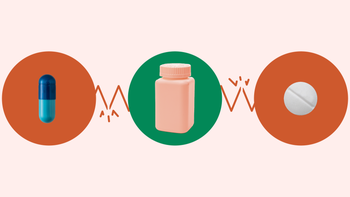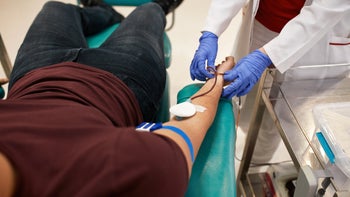
Thalassemia vs. Sickle Cell Disease: What’s the Difference?
Key takeaways:
Thalassemia and sickle cell disease are both genetic disorders that affect the hemoglobin in red blood cells, but in different ways.
Both thalassemia and sickle cell disease can run in families. The severity depends on which and how many genes you inherit from your parents.
Sickle cell disease is often diagnosed in early childhood, while thalassemia may not be obvious until later in life.

You’re more likely to have heard of sickle cell disease and thalassemia if you have family from Asia, Africa, or the Mediterranean. These diseases are types of inherited anemias — blood disorders that affect red blood cells and can be passed down in families.
Some people with thalassemia develop symptoms in childhood, while others may not even know that they have it until medical testing for something else finds it. And some people may have both thalassemia and sickle cell disease. The science and the genetics can get complex, but the important thing to know is that screening is easy for these conditions. Let’s dig in.
How is thalassemia different from sickle cell disease?
Thalassemia and sickle cell disease are genetic disorders that affect red blood cells. They both affect the hemoglobin molecule in red blood cells. The hemoglobin molecule is the protein part of the red blood cell that binds to oxygen and carries it around the body. Hemoglobin has an alpha chain and a beta chain.
Prescription Savings Are Just the Beginning
See what other benefits you qualify for—from cashback cards to cheaper insurance.

The term for a disease that affects hemoglobin is “hemoglobinopathy.” Thalassemia and sickle cell disease are both hemoglobinopathies, but that’s where the similarities end.
Thalassemias can affect either the alpha or the beta chain. Sickle cell disease affects only the beta chain.
Thalassemia and sickle cell disease also affect the hemoglobin chains in different ways.
In thalassemia, someone can’t make enough normal hemoglobin. Because of this they have fewer red blood cells and lower blood oxygen levels than normal. Someone might not make enough of the alpha or beta proteins in hemoglobin, or they may not make enough of either.
In sickle cell disease, the beta hemoglobin chain twists and changes the shape of the red blood cell. Normal red blood cells are round, like little frisbees. In sickle cell disease, the red blood cells are “sickled” in a croissant shape. Sickle cells can clog small blood vessels and prevent the delivery of oxygen around the body.
This causes complications, like breathlessness, pain, strokes, and blood clots. It also causes problems in the spleen, which means that people with sickle cell disease have anemia and a higher risk of certain infections.
Read more like this
Explore these related articles, suggested for readers like you.
What causes thalassemia and sickle cell disease?
Both thalassemia and sickle cell disease are genetic conditions that a parent can pass down to a child. In both cases, how severe the disease is depends on how many genes someone inherits.
For example, a child who inherits abnormal hemoglobin genes from one parent and normal hemoglobin genes from the other will carry the disease. In most cases, the child may not have any symptoms (or only minor ones), but they can still pass the genes on to the next generation. This is why some people may not even know they have thalassemia until they have medical testing for another reason, or until another person in their family is diagnosed.
There are many hemoglobin gene abnormalities and combinations that can cause thalassemia. And people experience it differently. Some people don’t have any symptoms, but for others thalassemia can be mild, moderate, severe, or even fatal at birth.
Sickle cell disease is similar. Children who inherit a sickle cell disease gene from both parents will have the disease. But children who inherit the gene from only one parent will have sickle cell trait. People with sickle cell trait do not have symptoms, but they can pass the genes on to their children.
Who is at risk for thalassemia or sickle cell disease?
Because thalassemia and sickle cell disease are genetic conditions, they are more likely to happen to people from a similar genetic or ethnic background. Alpha thalassemia is more common among people whose families are from Asia or Africa. Beta thalassemia is more common among families from Mediterranean countries, although it’s also in Asia and Africa.
Sickle cell disease is common among families from Africa, South and Central America, the Caribbean, Saudi Arabia, India, and the Mediterranean.
Can you have sickle cell and thalassemia together?
Because the genes for sickle cell disease and thalassemia are common in the same parts of the world, people at risk of inheriting a gene for sickle cell disease are also at risk for inheriting a gene for thalassemia.
So, yes, someone can inherit a gene for sickle cell disease from one parent and a gene for thalassemia from the other parent. When this happens, that person will often develop sickle cell beta thalassemia. There are two types:
People with hemoglobin sickle beta-zero thalassemia have more severe symptoms, similar to sickle cell disease.
People with hemoglobin sickle beta-plus thalassemia have milder symptoms.
How do you diagnose thalassemia and sickle cell disease?
Testing for both thalassemia and sickle cell disease can use many different blood tests, including:
Complete blood count (CBC): to check for anemia
Hemoglobin electrophoresis: a blood test that looks at the types of hemoglobin in your blood
Blood iron studies: to see if low iron is causing anemia
Genetic testing: to see if you or others in your family carry genes for thalassemia or sickle cell disease
Prenatal testing: to find out if a baby inherited specific genes
Some types of thalassemia are mild, so someone may not even know they have it. But people with moderate and severe types of thalassemia often get a diagnosis by the age of 2, or even as early as 6 months. Prenatal testing or a newborn screen can diagnose sickle cell disease early.
Don’t hesitate to get tested. It’s especially important if you or a loved one have signs or symptoms of anemia and risk factors for thalassemia or sickle cell disease based on ethnic background or a family history of the condition.
What are the symptoms of thalassemia?
Symptoms of thalassemia depend on the type (alpha or beta) and how severe the disease is. Some types of thalassemia cause only mild disease, while others cause severe disease or can be fatal at birth. How severe someone’s thalassemia is depends on which and how many thalassemia genes they inherit from their parents.
Thalassemia can cause many different symptoms because it can affect different parts of the body. Possible symptoms include:
Fatigue, shortness of breath, and fast heart beat from low oxygen levels
Pale skin from reduced blood flow
Yellow skin (jaundice) and gallstones from the breakdown of red blood cells
Abnormal bone growth from bone marrow expansion
Slow growth rate in children due to anemia
People with severe forms of thalassemia may need frequent blood transfusions. Repeat transfusions can increase the amount of iron in your body and can cause iron-overload symptoms, such as:
Bronze skin
Liver failure
Low thyroid function
What is the treatment for thalassemia?
The treatment for thalassemia depends on how severe the disease is. Mild thalassemia may not need any treatment. People with severe thalassemia may need regular blood transfusions, every 2 to 4 weeks. Blood transfusions do not cure thalassemia, but they can give you healthy red blood cells that can carry oxygen normally and can help you stay active. People with moderate thalassemia may need a blood transfusion from time to time, like during periods of stress or illness.
Other treatments for thalassemia include folic acid, which is a type of B vitamin and a very common treatment. Some people who need regular transfusions may also need iron chelation therapy, which is a treatment to prevent iron overload.
Stem cell transplant can cure thalassemia, but it’s a high-risk procedure that isn’t common.
The bottom line
Thalassemia and sickle cell disease are both inherited red blood cell disorders. But they aren’t the same. There are different types of thalassemia and sickle cell disease, and how serious the disease is depends on the genes you inherit from your parents.
It’s important to get tested if you or people in your family have symptoms of anemia and your genes come from a part of the world where these blood disorders are more common. Knowing the exact cause of your symptoms is an important first step in getting the treatment you need, feeling better, and reducing your risk of complications.
Why trust our experts?


References
Bajwa, H., et al. (2021). Thalassemia. StatPearls.
Centers for Disease Control and Prevention. (2020). What is sickle cell disease?
Centers for Disease Control and Prevention. (2020). What is sickle cell trait?
Centers for Disease Control and Prevention. (2022). Data & statistics on sickle cell disease.
Centers for Disease Control and Prevention. (2022). Thalassemia: Complications and treatment.
Genetic and Rare Diseases Information Center. (2021). Thalassemia.
KidsHealth. (2019). Newborn screening tests.
National Heart, Lung, and Blood Institute. (2022). Sickle cell disease: Diagnosis.
National Heart, Lung, and Blood Institute. (2022). Thalassemias: Diagnosis.
National Heart, Lung, and Blood Institute. (2022). Thalassemias: Treatment.Sedrak, A., et al. (2021). Sickle cell disease. StatPearls.




























